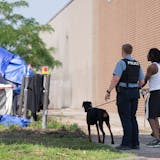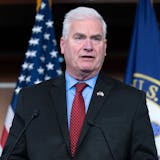New county COVID-19 data shows what a difference a week can make — with 27 counties seeing enough changes in the spread of the infectious disease to end up in different categories when it comes to school reopening plans.
The changes underscore the volatile nature of COVID-19 numbers at the local level, amid a pandemic that has caused 58,640 lab-confirmed infections and 1,636 deaths in Minnesota, and the challenges school districts face in sizing up infection risks for the fall.
Gov. Tim Walz acknowledged the difficulties during a press event Thursday in which he lamented that his son will start eighth grade with online instruction in St. Paul; engaged a teacher in an impromptu exchange about her fears; and asked Minnesotans to maintain the mask-wearing and social distancing that can help keep businesses and schools open.
"I would tell teachers, students and parents, I wish there were more certainty around this, but the virus is not allowing us that," the governor said. His comments came after he visited the Community Action Partnership of Ramsey and Washington Counties on Thursday to highlight state benefits and assistance programs that remain available to Minnesotans as the $600 weekly federal unemployment benefit ends.
Lincoln County saw its 14-day case rate per 10,000 people decrease from 70 last week to 40 in updated data released Thursday. That moved it under the state's new school reopening plan from a recommendation for only online instruction to at least a hybrid approach of in-class and online learning for elementary school students.
Meanwhile, Norman County in northwestern Minnesota saw its rate bump up from nine to 15 — enough to switch from a recommendation of in-person learning in all schools to a hybrid approach in middle and high schools.
When Walz announced his school reopening plan last week, he urged people to not dwell too much on the county numbers, even though they offered guidance to local school districts on what to do. His plan offered a graduated scale of recommendations from all in-person classes in schools in counties with case rates of less than 10 per 10,000, but all online instruction in counties with case rates of 50 or more per 10,000.
Other circumstances are a factor, the governor said, including whether social distancing of 6 feet can be adequately maintained.

